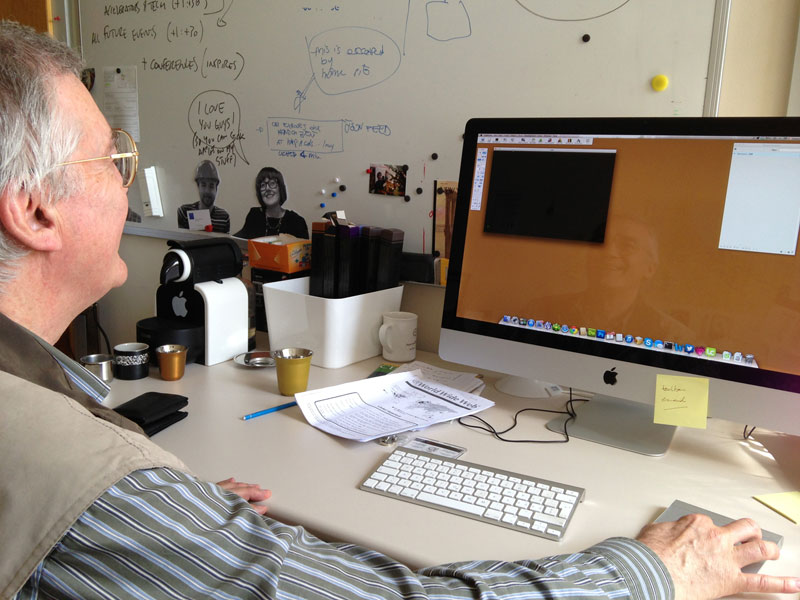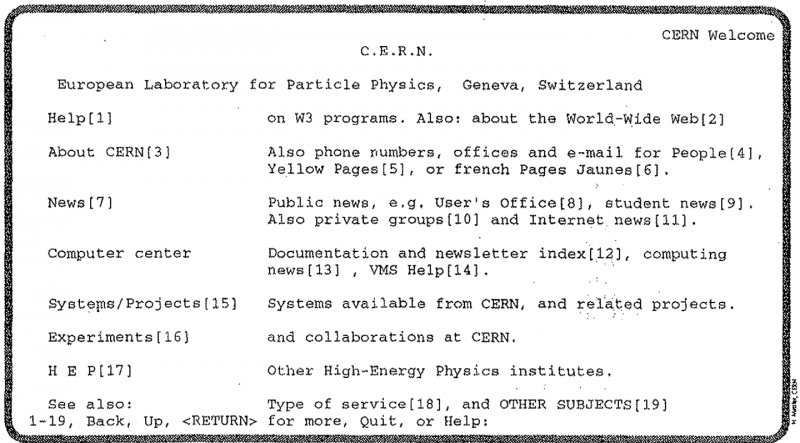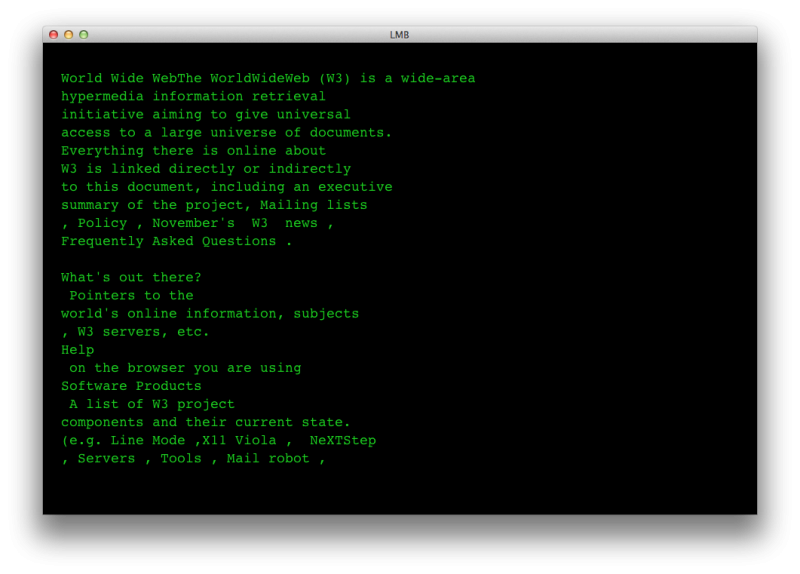I just spent an enjoyable morning with Robert Cailliau, looking at options for recreating the line-mode browser experience. He turned up at my office with a very rough, but working, prototype that he had put together himself using LiveCode.

Robert Cailliau cobbling together a line-mode browser
LiveCode is a cross-platform rapid application development platform that can create desktop applications and apps. LiveCode was no doubt inspired by Hypercard, which was a hypermedia system that predated the the web - I like this thought, for some reason.
The line-mode browser was a really simple early browser that could be used by terminals and a variety of fairly basic machines. It didn't require a mouse or graphical capabilities: the user would simply read web pages and hit keys to scroll (or, rather, go to the next page), follow links and so on. The display was pretty basic: just 80 characters wide by 24 high. Here is an early screenshot of the line-mode browser showing the CERN homepage that dates back to the early 1990s:

A (printed) screenshot of the line-mode browser. Users would type commands rather than use a mouse or a touch interface.
If you look at the content of the page you can see numbers in square brackets peppered through the text. These are numbers that relate to links that the user could follow by typing the number and hitting <return>. Typing number 2 would take the user to http://info.cern.ch, I would imagine.
A number of interesting thoughts came out of my discussions with Robert which I thought I would share here:
Key mappings
Look back at the line-mode browser screenshot. At the bottom it says to type numbers (for links) or 'back', 'up', 'quit' or 'help'. I presume these commands mapped to either specific keys, or that the user could type the commands directly ('help' or 'h' and then <return>).
Was there a mapping between obsolete keys such as the 'page up' and 'quit' keys that were on many earlier keyboards?
Badly-constructed HTML and authenticity
During Robert's demonstration we talked about how to handle badly-formed HTML. "Too bad," said Robert, "the line-mode browser never had that!"
It's an interesting thought. Should whatever we produce to recreate the experience of using the line-mode browser cope with badly-formed HTML? If it didn't, then it would be rather limited beyond being used to read, say, only the content of info.cern.ch. This would be a shame, but would it be more authentic to handle it this way?
Line-mode browser on touch
LiveCode allows you to create apps. I hadn't really thought of doing this for the line-mode browser before. Would it make any sense at all on a touch device?
Rendering HTML elements in the line-mode browser
The screenshot looks as if it's displaying tabular data with a scannable left column and more information on the right. But knowing what sticklers for semantic markup the early WWW team were I cannot imagine that this is a table. What was it - a definition list? What other elements had a special visual treatment within the line-mode browser? Note the first paragraph, for instance, which appears to have a leading line indent.
What next for the line-mode browser
Creating a downloadable application is just one avenue we're exploring. We're also looking at creating something that you can use directly with a modern browser. More on this soon. In the meantime check out Robert's first attempt in LiveCode:

A quick proof-of-concept version of the line-mode browser. This screenshot doesn't show the anchors as being addressable, but Robert got this going...
Dan Noyes on

Comments
Submitted by Geoff Shearer (not verified) on 07 May 2013 Permalink
You can see an old page that
You can see an old page that simulates the early web at the following link:
http://www.dejavu.org/
Note that the Line Mode Browser is there. However, I don't think those pages have been updated for a while.
Also, a more "modern" version of the LMB can be installed as a Redhat package - it is still in the repository, and I tested it under Fedora 18. It is ghastly for any modern website.
Submitted by Default Placebo (not verified) on 16 May 2013 Permalink
Posted to @firstwebsite on
Posted to @firstwebsite on Twitter; "rechirped" in vastly expanded form here:
Robert Cailliau is definitely on the right track with an emulator of the earliest of www browsers, but that line-mode needs to reside as a webapp at (or linked to from) http://info.cern.ch/ - not as a standalone/ downloadable, I presume, runtime binary demo. Because only in this fashion can one get a glimpse of how it felt to access WWW before it really took off, and when it was usable even from teletypewriter—no display screen—terminals (and I remember the time, when there were less than 100 websites in the entire world: #1 @ CERN, #2 SLAC, #3 NCSA, etc).
As an aside I find it no little ironic, that in 25+ years of desktop workstation use, there is no better tool for quick (yet robust enough for industrial deployment) prototyping than an evolved clone of Bill Atkinson's 1987 Hypercard®. Had Apple any sense of what KillerApp™ they killed a decade ago, they'd bring it back this instant. As you can gather, sadly, I do not speak for Apple ;-((
Also see my April 30 20th dab-dab-dab-anniversay tweet about it
https://twitter.com/velorg/statuses/329183759654068224